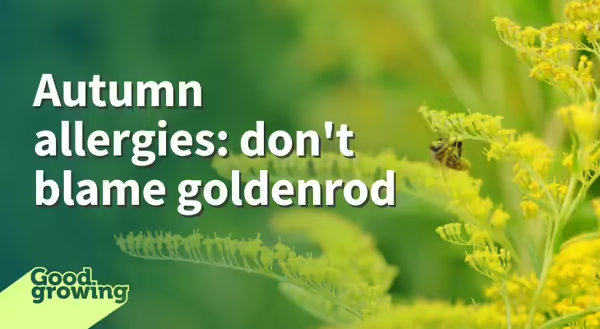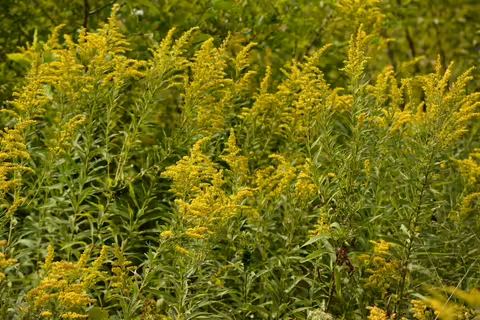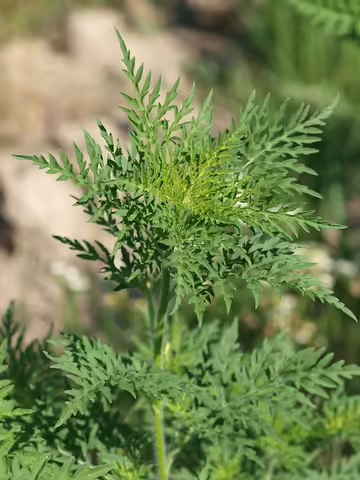
As the growing season draws to an end, temperatures cool, woody plants prepare for dormancy, and we enjoy the last blooms of the season. For many of us, autumn also means sniffles and sneezes caused by seasonal allergies.
Seasonal allergies are a reaction to airborne pollen entering the body and being misidentified as a threat. Itchy eyes, runny noses, sneezing, and congestion are frustrating symptoms, so many of us look around for the culprit and notice the bright yellow blooms of goldenrod. The correlation between seasonal allergies and the bloom time of goldenrod is strong but this does not equal causation. Goldenrod is not to blame…ragweed is the guilty species.
Mistaken Identity
Goldenrod species (Solidago spp.) bloom bright yellow throughout the Midwest in our wild spaces and backyards. The bold blossoms attract the attention of insect pollinators and people. With this comes a curse, it is often accused as being the source of allergy-causing pollen. However, being insect pollinated, goldenrod produces pollen grains too heavy to be transported by wind. The allergy-causing culprit is ragweed.
Giant ragweed (Ambrosia trifida) is native to the Midwest and is a wind-pollinated, annual plant. Each autumn, giant ragweed takes its best shot at reproduction by releasing millions of pollen grains into the air. Having no need to appeal to insect pollinators, ragweed flowers are green and blend into the landscape. But for allergy sufferers, ragweed pollen demands attention.
Pollen and Plant Reproduction
For any species, reproduction is the name of the game. Without producing offspring, species cease to exist. In the plant kingdom, most reproduction is achieved through seed development. How are those seeds produced? Well, this is where the birds and the bees conversation becomes literal and how we know goldenrod is not to blame for our seasonal allergies.
It is estimated that 88% of the world’s plants are pollinated by animals moving pollen grains from the male anther of a flower to the female stigma of the same or another flower. The remaining 12% of plants rely on the wind to disperse pollen.
Generally speaking, plants that rely on animals for pollination have evolved strategies for attracting animals to their flowers. Bright color blooms, fragrances, and nectar rewards help entice pollinators to visit plants, putting them in a position to transport pollen from flower to flower. These pollen grains are often large and sticky to hitch a ride on the backs, legs, heads, or bodies of pollinators.
Plants that use wind to transport pollen grains rely on numbers to win the game of reproduction. Wind pollinated species produce and release millions of small, lightweight pollen grains into the air, hoping that a few will land on the female structures to complete pollination. The ratio of triumphant pollen grains that land on female structures is low compared to those that hit other targets, including people.
Allergies and the Environment
According to the Centers for Disease Control and Prevention (CDC), hay fever affects as many as 60 million people each year in the United States. The CDC also reports that the changing climate has the potential to lead to a greater abundance of pollen being produced and an extended pollen production season, causing more people to suffer.
Shifts in precipitation patterns, extension of the frost-free growing season, warmer seasonal temperature, and an increased amount of carbon dioxide in the atmosphere contributes to the extended allergy season. Early evidence also indicates that the potency of the allergenic protein in ragweed will also increase as more carbon dioxide is available in the atmosphere.
Good Growing Fact of the Week: Goldenrod makes a great cut flower for fresh arrangements and dries well for dried floral arrangements without causing sniffles.
Ragweed photo: "Ambrosia artemisiifolia (Ragweed)" by F. D. Richards is licensed under CC BY-SA 2.0.
Signup for our emails! Want to get notified when new Good Growing posts are available? SIGN ME UP
MEET THE AUTHOR
Emily Swihart is a Horticulture Educator with University of Illinois Extension, serving Henry, Mercer, Rock Island, and Stark counties since 2021. Emily provides horticulture programming with an emphasis on trees, native vegetation, and home landscape design.

